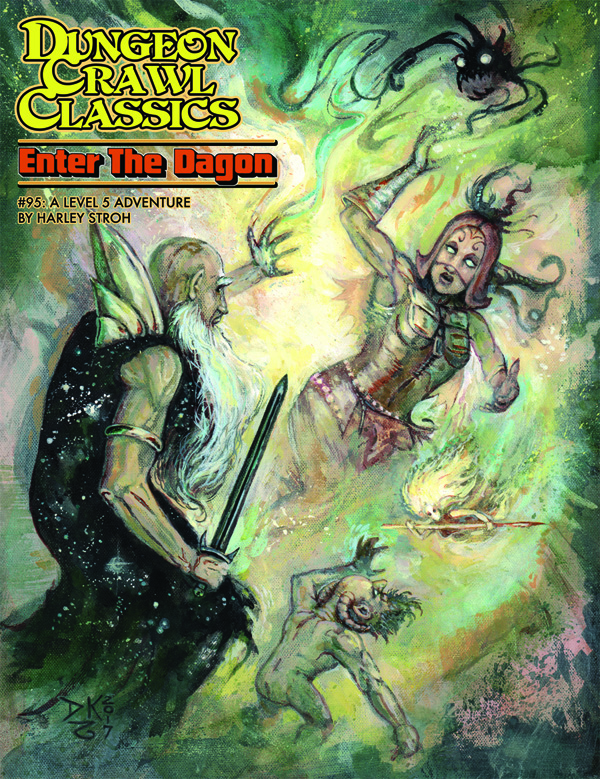 |
| Saw the cards, didn't see the Quinns...too bad, since I'm a fan |
Summary: A great experience!
Let me list some of the standout takeaways I had from Gen Con 2017:
- First off, I met a lot of terrific folks. From my roommates at the hotel, to the organizers, and occasional encounters with admired creators, I was impressed with everyone I met who was connected with Goodman Games. I'll have to enumerate this in more detail at a later point; to avoid leaving anyone out, I'm going to temporarily leave everyone out! But suffice to say, I made a few new friends in the community, and that's always an awesome thing.
- It wasn't just the folks I met at good old Goodman Games. Fellow conventioneers were uniformly friendly and considerate. Not only that, but staff at the hotel (Embassy Suites) and Indianapolis Convention Center were very professional and courteous. Heck, I have to say that I have an excellent impression of the people of Indianapolis: genuinely friendly and polite. These are all very distinct crowds, but all seemed positive on the balance.
- My GMing skills got a great workout, and the games were all fun to run. I feel like I both enjoyed myself and learned a lot. This was complemented by a few very interesting discussions with some of those roommates about GMing technique and philosophy.
- Despite some initial minor stage fright, I felt pretty comfortable narrating about ghosts and titans in front of people I had just met. But making myself heard by a half-dozen people in a room full of sixteen energetic game sessions beat the shit out of my throat, and four sessions in four days was pretty damn taxing for me. That said, I can definitely see myself going back.
- I didn't play a lot of games, but I don't have any regrets about that. I'm glad I was about to focus on GMing this time; next time, I'll be more comfortable mixing it up.
- That said, the one session I was a player was amazing. It wasn't even part of Gen Con; it was Dougcon, or Doug Kovacs' adventure designed, well, expressly for this purpose (i.e. to be played in the hotel bar by Goodman people). I would love to post shots of the Doug's wonderful art and layout, not to mention describe the whole thing in detail, but I'm not sure if that's OK, because this thing is far from being published. In any case, it was inspirational for me - it showed me a totally different way that an adventure and could be structured. And it really worked!
- I didn't spend much money, but I got some great DCC adventures and other materials. The Gen Con 2017 Program Guide has an impressive amount of content, including a partial adaptation of the old Goodman property Broncosaurus Rex to DCC mechanics. However, I was particularly taken with Harley's new joint, Enter the Dagon. This isn't available outside the convention floor, yet, but I'm sure it's a matter of time. I'll probably review it in another posting (edit: done), because it's that good and I really want to talk about it. Also, it was great meeting Harley, and I did the fanboy thing and got him to sign my copy of Dagon.
 |
| Not yet available from Goodman or DriveThru (but it will be soon) |
To be specific about what games I ran: two sessions of Bride of The Black Manse and two sessions of The Hole In The Sky. These were run over four days, one per day, in that order. Without exception, I'd say that my players were all smart, engaged and fun. So that's another positive.
 |
| DCC at Gen Con 2017 |
Last post, I forgot to include a closing section on what I learned. I mentioned something earlier in that post (i.e. it's all in the presentation), so let's go with that. But what about this post?
I could easily write a long post entirely devoted to what I learned about GMing at Gen Con. So I'll save that full exegesis for later. For now, I'll focus on something that's currently on my mind: pacing.
I over-prepared a bit for my sessions, creating paper miniatures that I never ended up using. That's just as well, since I ran two funnels with twenty-four PCs at the start of each. Can you imagine placing and moving and keeping track of all those PCs? Combat would have taken forever.
 |
| They look quite sharp if you put a little time into it |
By relying on an abstract representation of things (i.e. the "theater of the mind") along with some rule patches and specialized spreadsheets, I was able to keep what felt like an excellent pace. I created a few printed grids to keep track of initiative (PC and NPC) and hit points (NPC). That made it easy to quickly cycle through each combatant, resolving each without delay. These are nothing mind-blowing, but I added links to the Google docs below.
Rulings-over-rules is a beautiful concept for so many reasons, but when I'm running published materials, I'm not afraid to create some simple baseline mechanics to handle important situations like:
- How does one "master" the soul stone in Manse?
- What are the chances of different things waking up the titan in Sky?
- How hard is it to climb the outside of the prison in Sky? Is it even possible?
- etc.
By the way, each of these questions came up multiple times in my dry runs and at Gen Con itself. You might be surprised how many common situations come up that the adventures don't address. You really have to think on your feet, or do a little preparation. One thing I've learned is that the GM always needs an answer to the question "Can I light it on fire?"
So I'd sum all this up by saying I was able to keep my games moving at a brisk pace (for me, at least) by identifying points that things can slow down - i.e. combat, ambiguous mechanics - and preparing for them. In my case, preparation meant spreadsheets and devising my own clarifications.
Combat always runs the risk of becoming a slog. DCC gives the table a lot of tools to keep things exciting and fast-moving, but it's ultimately down to the GM and, to a lesser extent, the players. The GM has to have a solid grasp of the basics, the ability to quickly find stuff like critical tables, and a willingness to make a good ad hoc ruling when all else fails.
Anyway, to whatever extent it helps, here are those spreadsheets that I made (actually table templates but whatever, you pedant) that helped me run DCC quicker at the table.
The first one is a matrix for NPC/enemy initiative totals and hit points. The Judge writes the name of each creature the PCs face in the first column, devoting the row to that creature. In the next column goes its initiative total, however it is determined. Finally, in the third column, the GM writes the NPC's starting hit points. As these are reduced, write the new value in the cell to the right. If the GM anticipates needing more columns for hit points, he can devote more than one row to an adversary.
The second game aid is a matrix for the PC initiative. This is useful for the GM to always know who acts next. At the start of the session, the GM can write the name of each player and/or character in the leftmost column. Each column to the left of that is devoted to a single combat. For each fight, the GM can record the rolled initiative for all PCs in a column, cycling through them each round and interspersing actions from NPCs as recorded on the matrix described above.
You're best off printing out a few copies of these before a gaming session, although I never went past one of each sheet in any of my four-hour sessions. They can be copied and used digitally, although that's rarely as intuitive as working with paper.
Feedback is welcome!
 |
| Sometimes it feels like this |
Anyway, to whatever extent it helps, here are those spreadsheets that I made (actually table templates but whatever, you pedant) that helped me run DCC quicker at the table.
The first one is a matrix for NPC/enemy initiative totals and hit points. The Judge writes the name of each creature the PCs face in the first column, devoting the row to that creature. In the next column goes its initiative total, however it is determined. Finally, in the third column, the GM writes the NPC's starting hit points. As these are reduced, write the new value in the cell to the right. If the GM anticipates needing more columns for hit points, he can devote more than one row to an adversary.
The second game aid is a matrix for the PC initiative. This is useful for the GM to always know who acts next. At the start of the session, the GM can write the name of each player and/or character in the leftmost column. Each column to the left of that is devoted to a single combat. For each fight, the GM can record the rolled initiative for all PCs in a column, cycling through them each round and interspersing actions from NPCs as recorded on the matrix described above.
You're best off printing out a few copies of these before a gaming session, although I never went past one of each sheet in any of my four-hour sessions. They can be copied and used digitally, although that's rarely as intuitive as working with paper.
Feedback is welcome!
No comments:
Post a Comment